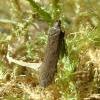35.040 Bryotropha terrella ([Denis & Schiffermüller], 1775)
Status and Distribution
Locally common to common and sometimes locally abundant throughout much of the British Isles and Channel Islands.

Provisional map
Foodplant and Larval Feeding Signs
Rhytidiadelphus squarrosus (springy turf-moss) and Agrostis capillaris (common bent). In Europe reported from Syntrichia ruraliformis, Hypnum jutlandicum and Caliergonella cuspidata.
In the early instars the larva constructs a fairly tough, opaque silken tube attached low down amongst the moss or grass with the upper end near the surface of the moss. This tube is covered with chewed fragments of moss and grass. In the final instar a more flimsy transparent gallery is constructed without any plant material attached.
Habitat
Finding the Moth
Larva: late winter searches of suitable areas of moss and short grass may reveal the very active larva.
Adult: easily disturbed from its resting area amongst the moss or on nearby vegetation during the day, particular in warm sunny conditions. In the evening females have been found nectaring on ragwort (Senecio jacobaea). It flies at dusk and comes readily to light.
Similar Species
This is a robust, relatively broad-winged Bryotropha with a range of forewing colour from pale buffish-brown to darker chestnut brown.
Can be similar in size and colour to some forms of B. desertella and B. politella when genitalia examination may be necessary. Where B. desertella is found in its usual sand-dune habitat it is smaller than B. terrella and has narrower forewings. Inland forms of B. desertella can be larger and darker overlapping to a certain extent with smaller B. terrella. Sometimes B. desertella can have a darker median streak in the forewing, a feature not present in B. terrella.
B. terrella can be confused with male B. politella although the latter has a smoother texture to the markings and rarely shows any sign of an angled fascia at three quarters. There is no significant darkening in the outer quarter of the forewing in B. politella and no cilial lines in the cilia of the hindwing. B. politella has a thinner body making B. terrella look more robust. Females of B. politella are lighter than most forms of B. terrella, resembling the coastal form of B. desertella, although the latter is smaller.
Single brooded from late May to mid-August with the peak in late July.
Earliest: 5th April 1997 (VC9)
Latest: 27th September 2003 (VC31)




















